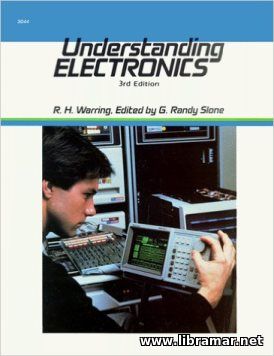 Another textbook on electronics for the newcomers. The book will help beginners understand some basic electronics concepts and also let them know how the basic equipment like diodes, voltage multipliers, amplifiers and other equipment are constructed and how they work. It will be very useful for hobbyists who are willing to dabble, and the authors do not go too deep in mathematics so reading the book is not that difficult.
The publication will also be good for the professionals to check and/or refresh their technical skills. Brief contents - Abbreviations and symbols used; Alternate and direct current; Basic circuits and electric circuit laws; Capacitors and resistors; Capacitor and RC circuits; Coils and inductances; Transformers and semiconductors; Neon lamps, LEDs, and liquid crystals technologies; Other components; Tubes; Integrated circuits; IC arrays; Transistor characteristics; Amplifiers; Oscillators; Circuit diagrams and construction; Printed circuits; Radio and TV technologies; Microprocessors; Batteries, power supplies, and chargers; High-voltage power supplies; Symbols and equations. Definitely recommendable book for all electronics specialists, students and enthusiasts.
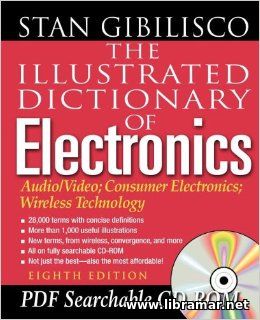 Here is the eighth, one of the latest, editions of the Dictionary, which has been significantly revised, updated, and clarified, and is now reflecting all latest technological advances. Many new definitions and terms have been included in the different fields of robotics, wireless technology and even artificial intelligence. The team of the authors working on this dictionary made every effort to be accurate yet concise, without any "talking down" to the readers.
Many of the definitions in this book contain cross references providing recommended additional info or allow the comparison with related terms. The expressions bearing the special significance have been printed in italics. Authors made their best to avoid using of the superfluous mathematics, but sometimes equations are still necessary to effectively and completely define a term.
However, no mathematics beyond the high school level has been used. The Appendix A addresses the standard symbols that are used in electrical/electronic diagrams and such symbols are also used in the illustrations throughout the dictionary. Appendix В contains the data tables addressing conversion between electrical systems, Greek alphabet, math functions and operations, prefix multipliers, and resistor color code.
 Here is an excellent book released with the intention to provide readers with the necessary overview of the very latest advances in the recommended practices and technologies, as well as recognized international technical standards to help them achieve safest, most efficient and most economical power delivery in a dynamic environment of today.
The topics in this book include protection, dynamics and stability, and operation and control of electric power systems. The present release of the publication contains five completely new and ten significantly revised chapters, supplying the highest level of detail. The material presented in the book is supplemented with so many professional images and graphs making it much easier for the reader to understand it. Among the new chapters there are ones addressing the wind power integration, systems aspects of large black-outs. stability assessment, dynamic security performance and others.
This handbook shall definitely be considered a very useful and practical tool that has to be there is every electrical technician's and engineer's library. Moreover, we would recommend this book even to the students wishing to fresh out their technical knowledge of the electric power systems.
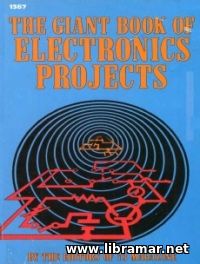 The present book of selected electronic projects is representing some of the best projects that appeared in the popular "73 Magazine". In this single volume the electronics experimenters will find various interesting projects - note that it will be also interesting to the radio enthusiasts and, in fact, literally anyone having an interest in electronics.
The projects included in this publication are covering all fields of electronics - from receivers to transmitters and from power supplies to testing equipment. The readers will even be able to construct some of the equipment themselves, just following the detailed instructions provided in the book. The authors have even included several simple projects for the beginners. The original intention of the authors was to provide all enthusiasts of electronics with a good compilation of tried, tested and proven electronics projects.
Five major chapters of the publication address power suppliers and power regulators, general testing equipment, special testing equipment, amplifiers, and receivers. Definitely recommended volume to anyone making his first steps in the amazing world of electronics, since it is really dealing with all important areas of electronics - it means that the readers will be given a good chance to apply their theoretical knowledge and may try to do something real.
 It is easy to say that this new book is for anyone involved with S7-300/S7-400 and SIMATIC NET networks, but in fact, this is the case. If you are a controls engineer, responsible for design and programming, a maintenance technician, an applications engineer, or sales representative, you'll find that this book provides much useful information.
The book offers significant coverage of configuration concepts, addressing memory and I/O. programming in STEP 7, defining network configurations, as well as a guide to using the tools for monitoring the program, and diagnosing problems in the hardware, software, or in the process. If you are a controls or applications engineer, your work will likely involve both configuring the hardware and programming for S7-300/S7-400 and SIMATIC networks.
You'll find examples ot the most typical configurations, as well as an explanation for various module parameters. In most cases, you'll find that the default parameters are generally usable, but you will learn how to obtain different operational behavior in the CPU and other modules. The Chapter on Working with STEP 7 Programs and Data is a great reference for learning about program design, data types and formats, instruction sets, and how to write code for Functions (FCs) and Function Blocks (FBs). You'll also learn the basics for structuring a program and calling blocks.
 This volume surveys the latest technologies that are used to satisfy the world's need for the cleanest and most efficient electricity and provides a good and thorough examination of the synchronous generators used for various applications. It offers readers a very focused treatment to the modeling and design, control of the performance and testing of the grid-connected and stand-alone generators being operated synchronously.
The publication gives a nice intro to the electrical energy and it's generation, and covers the basic principles of the operation of electric generators. Separate chapter has been devoted to the most popular models of the prime movers for the transients that are used for the active control of generators, while individual chapters of the book explore the various aspects of the large and medium-power generators.
There are many sample results, examples and illustrations highlighting the concept. The book will supply it's readers with all tools that are required to design the right power generation technologies, validate and deploy them, and to fulfill the very complex energy requirements of tomorrow. An excellent book on the topic and perfect reference source for anyone involved in design, construction, operation, maintenance and/or repair of the generators.
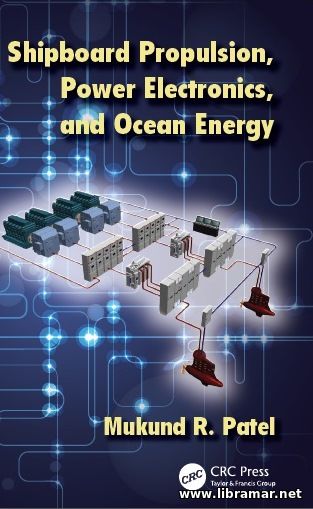 This handbook is intended to cover all modern technologies related to the propulsion of the vessels and power electronics as well as ocean energy. The material in question has been studied with the depth and breadth that the reader will hardly find in any other publication of same kind. The author has made a good attempt to examine the power electronic systems utilized for vessel propulsion as well as for extracting the energy of the ocean, which shall be treated as the mirror images.
The publication comprises of sixteen chapters divided into four major parts, namely power electronics and motor drives, in which the author explains the very basic converters and drives, cooling methods and power quality, electric propulsion technologies, mainly focusing on the ships propulsion by means of the superconducting motors and other latest technologies, renewable ocean energy, exploring the energy coming from the ocean waves and currents as well as from the wind farms installed offshore, and, finally, system integration aspects, where the author is discussing the energy storage and system reliability factors, essential for any of the power systems.
This is a really ideal textbook that may be used even in marine academies with engineering programs. It will be equally useful to marine engineers, ship constructors and all other specialists.
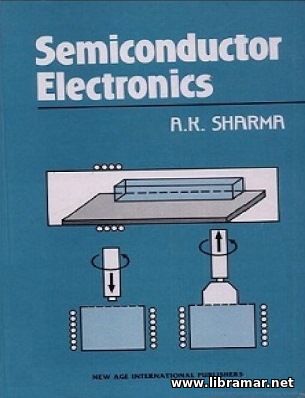 The present book begins with the very brief intro to the basics of the semiconductor technology, including their structure, band theory of crystals and description of the energy level diagram. Difference between extrinsic and intrinsic semiconductors is explained in this opening chapter, and types (N- and P-) of the extrinsic ones have also been covered together with some other information.
The next chapter has been dedicated to the semiconductor junction diodes while the third one addresses the diode circuits and provides the necessary information about clippers, clampers, rectifiers, comparators, filter circuits, voltage multiplying circuits etc. Then there comes a chapters dealing with the transistors, integrated circuits, and their fabrications.
The rest of the titles include transistor biaising techniques, two-port network theory and circuit models, small signal basic amplifiers, multistage and feedback amplifiers, power, tuned and wideband amplifiers, oscillators, multi-vibrators, basic logic gates, and other information. Definitely needful publication for the electricians and all people dealing with the design, maintenance and repair of the electrical equipment and systems.
« 1 2 ... 7 8 9 10 11 ... 14 15 » |







